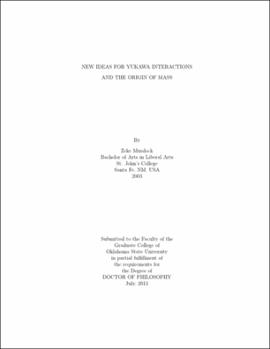| dc.contributor.advisor | Nandi, Satya | |
| dc.contributor.author | Murdock, Zeke | |
| dc.date.accessioned | 2013-11-26T08:26:35Z | |
| dc.date.available | 2013-11-26T08:26:35Z | |
| dc.date.issued | 2011-07 | |
| dc.identifier.uri | https://hdl.handle.net/11244/6906 | |
| dc.description.abstract | I explore new ideas in the Yukawa sector of the Standard Model. Very little is known experimentally about the Yukawa sector. We have yet to discover the Higgs boson. We have not experimentally measured the Yukawa couplings. Because so little is known, this is a good area to explore changes to the Standard Model. The gauge sector has been extremely successful in predicting experimental results. This makes any modifications severely constrained. I discuss four ways in which modifying the Yukawa sector can produce interesting results that can be tested experimentally at colliders. | |
| dc.description.abstract | In chapter 2 dimension 6 operators, instead of the usual dimension 4 operators, are used to give mass to the fermions. If this theory is correct, it broadens the recent exclusion range for the mass of the Higgs boson from the Tevatron and also increases the double Higgs production. | |
| dc.description.abstract | In chapter 3 a Froggatt-Nielsen mechanism is used to generate the masses and mixings of the quarks in the Standard Model. The Yukawa couplings in this model are all of a similar order. The hierarchy of masses in the Standard Model is generated through higher order interactions involving vector-like quarks and singlet scalars. I show that in one parameterization the higgs diphoton signal is increased by a factor of 10. This mode is very good for early Higgs searches at the LHC. | |
| dc.description.abstract | In chapter 4 a fourth generation is added to the MSSM. Limits are placed on the masses of fourth generation particles based on the perturbativity of their Yukawa couplings. We place very stringent limits on the parameter tan beta and the masses for the b' and t' quarks. In order to broaden these limits we construct a model in which the Yukawa couplings are modified by the introduction of new heavy vector-like quarks. | |
| dc.description.abstract | In chapter 5 the problem of Neutrino mass is discussed. We introduce a new way to give masses to neutrinos by fine tuning the values of two different Yukawa coupling matrices. This allows us to have a right handed neutrino that has a mass of about 100 GeV. The new Yukawa interactions change the decay modes of the Higgs drastically, and can be tested at the LHC. | |
| dc.format | application/pdf | |
| dc.language | en_US | |
| dc.rights | Copyright is held by the author who has granted the Oklahoma State University Library the non-exclusive right to share this material in its institutional repository. Contact Digital Library Services at lib-dls@okstate.edu or 405-744-9161 for the permission policy on the use, reproduction or distribution of this material. | |
| dc.title | New ideas for Yukawa interactions and the origin of mass | |
| dc.contributor.committeeMember | Babu, Kaladi | |
| dc.contributor.committeeMember | Rizatdinova, Flera | |
| dc.contributor.committeeMember | Binegar, Birne | |
| osu.filename | Murdock_okstate_0664D_11561.pdf | |
| osu.accesstype | Open Access | |
| dc.type.genre | Dissertation | |
| dc.type.material | Text | |
| dc.subject.keywords | collider | |
| dc.subject.keywords | higgs | |
| dc.subject.keywords | high energy | |
| dc.subject.keywords | neutrino | |
| dc.subject.keywords | quark | |
| dc.subject.keywords | yukawa | |
| thesis.degree.discipline | Physics | |
| thesis.degree.grantor | Oklahoma State University | |
